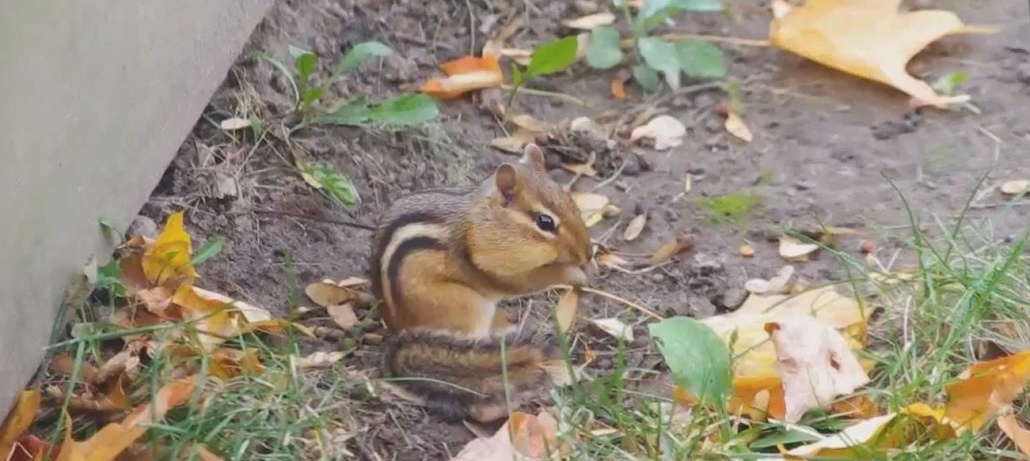- Chipmunk Removal - Information about the humane trapping and removal of chipmunks.
Chipmunk Removal
Chipmunks live in the northeast USA and the midwest. They are mostly cute and harmless, but some people don't like their habit of digging in lawns and burrowing next to houses or under concrete walks, in landscaping, etc.
Chipmunk Information
COMMON PROBLEMS: Chipmunks are fairly common suburban environments throughout the midwest and northeast. They often live in people's yards, around landscaping, gardens, etc. They do dig and live in burrows, which can be fairly long. Thus, they cause some of the following problems:
- Digging burrows next to or under houses, or under other areas where one does not want digging.
- Eating flower bulbs or tree roots, or other decorative or crop plants that you don't want eaten.
- Digging up parts of the lawn.
- Eating bird seed
Biology
Chipmunks are probably the smallest member of the squirrel family. They have pudgy cheeks, a bushy tail, large glossy eyes and stripes over the face and body. There are a total of 25 species of chipmunks in the world. Chipmunks are omnivorous animals and like eating grains, fruits, nuts, birds’ eggs, berries, small frogs, worms, fungi, insects and sometimes other small animals such as mice. They are hoarders and spend most of their time collecting and storing their food so that they have a food supply when food sources become scarce. Chipmunks begin collecting and storing food in the autumn to prepare for the winter. A few species store all of their food supplies in one designated place while others are known to make several small heaps – or storage caches - at scattered locations. They also have small pouches in their cheeks which allow them to carry multiple food items from one place to other. Although they use the pouches to hold and carry food, they can and do oftentimes eat portions stored within while they work to gather more food. Some of the chipmunks in captivity are known to sleep for about 15 hours in a day. Depending upon the species they can be reddish brown to grey in color and their size can vary from seven inches to 11 inches. Chipmunks chirp like birds when they feel there is a threat around or to attract the females. They prefer to stay alone and only look for a partner when they are ready to mate. They are generally active during early morning and late afternoon.

Habitat
Chipmunks live in burrows with an entrance of only about two inches in diameter. The entrance to the burrow is difficult to locate because chipmunks make sure to hide their homes so that they are not easily seen. They carry the mud from around the opening of their burrows and scatter it at distant places to further make locating their homes more difficult. The burrows are a complex network of tunnels comprising of a nesting chamber, one or more storage chambers, a number of side pockets and a main tunnel connecting all these and special escape routes in case of an attack. The main tunnel can be 20 to 30 feet in length. They protect an area of fifty square feet around the opening or burrow. Chipmunks are found in North America and parts of Europe and Asia.
Life Cycle
Chipmunks live for around three years in the wild. They mate twice in a year – once each during summer and fall. The gestation period lasts for about 31 days and usually two to five babies – pups - are born at a time. The pups come out of the burrows for the first time after they are at least four to six weeks old. They leave the burrow to make their own and start a separate life by the time they are six to eight months old. During the winter season chipmunks are relatively inactive; however, they do not actually hibernate. They do not store fat in their bodies and rely on the food supplies stored in their burrows for survival during the winter months. If the weather is a bit warmer and the sun is out, chipmunks can sometimes be seen during the day in the winter time.
Diseases Chipmunks Carry
Chipmunks are carriers of a virus that causes Colorado Tick Fever to humans. High fever, headache and muscle ache are common symptoms of Colorado Tick Fever. They can also cause relapsing fever. Both of the diseases are basically transferred when the ticks living on chipmunks bite humans. Tick bites generally go unnoticed as they are painless. Though not known to cause rabies, there have been a very few reported cases where humans bitten by chipmunks developed rabies symptoms.
Chipmunk Nuisance Issues
Chipmunks can cause damage to the buildings and other structures by digging burrows under stairs, patios, retention walls and foundations. They also consume and damage food stored for pets. The entrance of their burrows might also result in a broken leg in case a pet or other animal steps into the hole by mistake.
Read more about chipmunk removal topics, including About Chipmunks and what kind of Damage Chipmunks Can Cause. Learn How to Get Rid of Chipmunks and the effectiveness of Chipmunk Repellents. Find out how to Kill or Trap a chipmunk, and the best ways to Keep Chipmunks Away from Yard or Landscaping.


